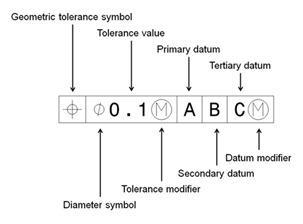
Why Use Geometric Dimensioning & Tolerancing (GD&T)?
It is the geometrical form of a feature, its orientation and/or its position relative to one or more other features that is crucial to the successful functioning of a component. In order to gain adequate control over such features, the limits of size applied to nominal dimensions have to be unnecessarily tight. If it is a geometrical aspect of a feature rather than its size that is crucial to its function, sometimes features that are not within dimensional limits can still be functional.
This realisation is said to have marked the beginning of GD&T.
Geometric Dimensioning and Tolerancing (GD&T) is a structured language of symbols, rules and definitions that allows the geometrical features of mechanical parts to be defined according to functional limits of imperfection. It defines the precise relationships between the geometrical features of a component by the application of tolerances to the following characteristics: flatness, straightness, circularity, cylindricity, angularity, perpendicularity, parallelism, position, symmetry, concentricity, profile and run out.
By employing GD&T to functional features on engineering drawings the designer is able to communicate to the manufacturer how much geometrical imperfection is tolerable before compromising the function of the component. Where the fit or function of a component is related to the size of a functional feature, the tolerance zone for that feature can be made flexible if appropriate. Controlling the functional features this way and allowing greater dimensional flexibility elsewhere on the component eases the manufacturing process and consequently reduces the cost of manufacture. The likelihood of producing scrap product is also reduced which leads to a further cost saving.
Since its conception in 1940, GD&T has developed gradually into a widely used universal language understood by design engineers, manufacturing engineers, inspectors, and quality personnel. It provides a comprehensive, methodical, logical, cost saving, feature based approach to the specification of engineering components.
For more information about our GD&T Training, visit our training section or contact us.




